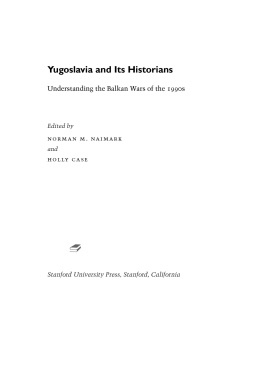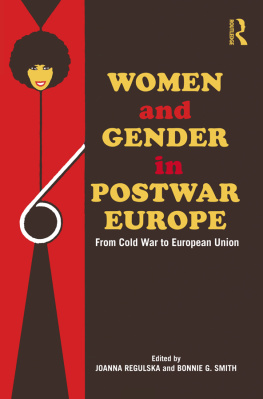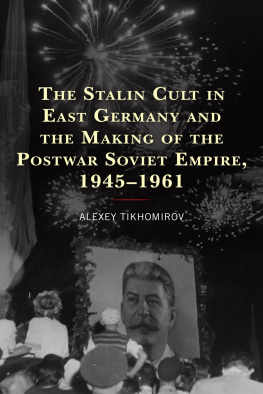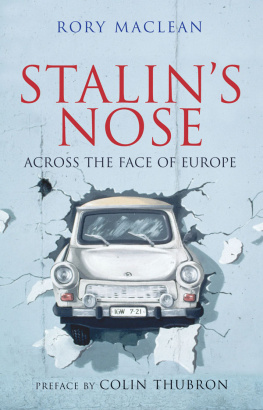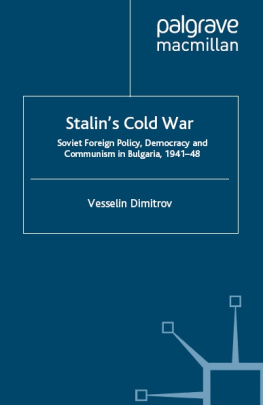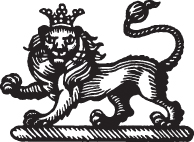Norman M. Naimark
Copyright 2019 by Norman M. Naimark
978-0-674-23877-0 (alk. paper)
Name: Naimark, Norman M., author.
Title: Stalin and the fate of Europe : the postwar struggle for sovereignty / Norman M. Naimark.
Description: Cambridge, Massachusetts : The Belknap Press of Harvard University Press, 2019. | Includes bibliographical references and index.
Subjects: LCSH: Stalin, Joseph, 1878-1953. | Cold War. | Communist countries Boundaries. | EuropeHistory1945- | EuropePolitics and
government1945- | Soviet UnionForeign relations1945-1991. | North Atlantic Treaty Organization.
Classification: LCC D843 .N266 2019 | DDC 940.55/4dc23 LC record available at https://lccn.loc.gov/2019012559
We forget, perhaps, how much of the world is not controlled by the Great Powers and how many people have a will of their own.
A. J. P. TAYLOR
The European continent was utterly devastated by World War II. Everywhere were destroyed cities and sad throngs of hungry faces. Whatever differences there might have been between eastern and western Europe in the interwar periodmostly deriving from economic underdevelopment over significant stretches of eastern Europewere leveled by the horrendous costs of the war in human lives and materiel. The continent as a whole was beset by hunger, apathy, unemployment, and, especially during the winter of 19461947, fierce coldthe worst in three centuries. Food and coal were in desperately short supply. Food production sank to two-thirds of the prewar level in part because of the shortage of fertilizer, livestock, and labor. Kerosene was found in some localities for light and cooking. Wood, charcoal, and peatwhen availableserved as the main sources of heat. Europeans were destitute, malnourished, and weakened by the low caloric intake. This in turn prompted the frequent appearance of pneumonia, diphtheria, tuberculosis, and typhus. Given the widespread shortages of drugsin particular penicillin, sulpha drugs, and antibioticsdisease, epidemics, and high rates of death from illness were inevitable. Not surprisingly, the elderly and very young were the most susceptible.
Tens of millions of people were on the move in 19441945: demobilized soldiers, returning POWs and forced laborers, expellees, settlers, deserters, and drifters in search of booty, work, and something to eat. Up to forty million people were displaced during the war.
Europeans in all parts of the continent resented ethnic minorities. During the war and after, the ruling nationalities carried out generally popular policies of ethnic cleansing. The Nazi leaders were the primary perpetrators of the violent deportations of peoples, but they also forcibly resettled Germans from the east to return to the Reich (Heim ins Reich) to take over the farms and properties of deported minorities. Once the war was lost, Germans themselves were driven from their former homes in eastern and central Europe in the millions, as the combination of changing borders and attacks by nationalist vigilante and militia groups exposed German communities to extreme danger. Hungarians, Ukrainians, Italians, Poles, and others faced the same fate in territories where they once held sway and were now no longer welcome. The victorious Soviets joined the act, both by approving the deportation of minority peoples and by cleansing their own territory of Poles and Germans.
Many targeted peoples tried to adopt new national identities to avoid expulsions, whether Italians in Dalmatia, Ukrainians in Poland, or Hungarians in Slovakia. German Silesians and Mazurians claimed that they were Poles. In the newly constituted Czechoslovakia, Yugoslavia, and Poland, judicial processes decided who was a native and who was not.
Yet everywhere, too, people sought solace in the latest dances and music, jazz and swing, and did what they could to come up with fashionable outfits to wear among the ruins, using the black markets that sprang up all over Europe to obtain occasional luxuries to distract themselves from poverty and want.
The psychological state of Europeans was complex and difficult. One Polish historian describes what he calls the great fear (wielka trwoga) experienced by the vast majority of Poles, a deep unease about what would become of them given the horrors they had endured, the extreme want that surrounded them, the political uncertainty of incipient communist rule, and the incessant rumors of a new world war. At the end of the war and beginning of the peace, suicide rates jumped to record numbers. Especially Germans and Austrians were terrified of the onslaught of Soviet troops and the impending occupation. But even after the war was over the challenges of staying alive and safe were too much for many Europeans.
Women were in a particularly psychologically challenging position at the end of the war. Their husbands, brothers, sons, and fathers were often absent, killed in the war, languishing in POW camps, or simply missing. Not only were they the primary workhorses of reconstruction, but for every surviving male there were 1.6 women of marriageable age.
Women and girls had their own traumas to bear, starting with humiliating accusations of and social punishment for horizontal collaboration in Norway, France, Poland, Italy, and elsewhere. There was also the ever-present threat and reality of rape and sexual violence by Allied soldiers, which continued even after the end of the war in all the occupation zones of Germany and Austria (though far worse in the Soviet zones), in France and Italy, and in east central Europe, especially in Hungary. Informal prostitution was known wherever Allied soldiers were billeted. The spread of syphilis and gonorrhea became a major issue for Allied commanders and for local health officials, especially given the shortages (or complete absence in the east) of penicillin. If infected, Soviet soldiers were forced to endure excruciating applications of mercury.
The occupations imposed burdens beyond those of threats to and violence against women. The Allies confiscated housing for their troops and villas for their officers, while many locals had to find shelter in barns and garages. They requisitioned food and coal, which were in desperately short supply. The Soviets took reparations from Germany and Austria, and removed supposedly German assets from eastern Europe, as well. The political officers of the victorious armies, east and west, often behaved with arrogant superiority toward the indigenous populations, which in turn aroused considerable resentment and anger. With some bitterness, Europeans noted that they would be glad to be liberated from the liberators. In all of the war-ravaged countries of Europe, planning for reconstruction was at the heart of government and policy planning. East and west, the desires of the extreme left and extreme right quickly made themselves known at the end of the war but faded quickly in comparison to the need for governments to take the lead in clearing rubble, rebuilding cities, and getting basic infrastructurewater, sewage, transportationback in place.


